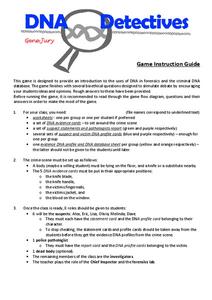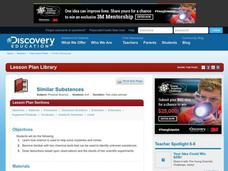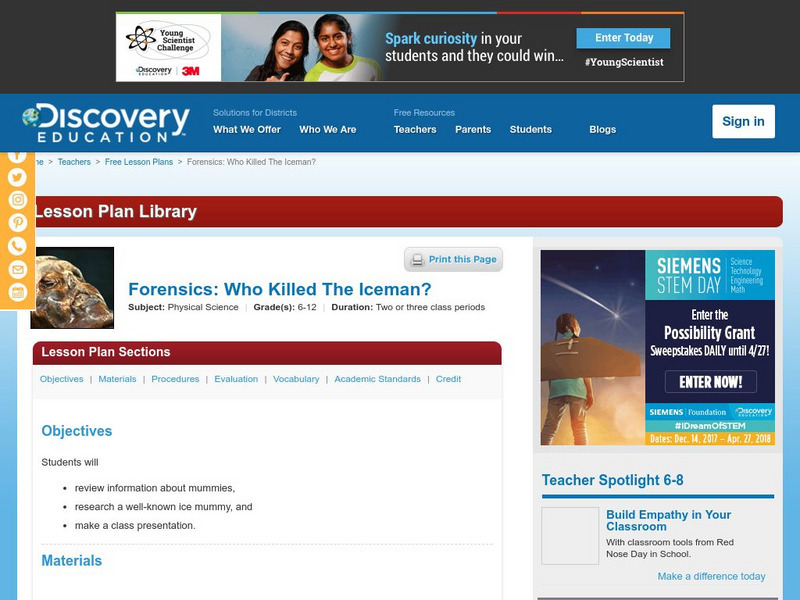Curated OER
Whodunnit?
Want to create an exciting mystery activity? Investigators will identify the elements of a mystery, review mystery stories, then write their own mysteries. They engage in forensic science experiments related to mysteries and learn to ask...
Media Smarts
Forensic Science Crimes Dramas
How do TV shows present criminology—is it realistic? High schoolers research crime dramas and participate in class discussion about topics such as who exists as the target audience and the values the shows communicate. They also research...
National Endowment for the Humanities
Kennewick Man: Science and Sacred Rights
"Have respect for the dead!" Scholars investigate how science and religion often clash. As they look into the laws of science and the laws of religion, the legal ramifications at the federal level of both play into an argument they...
Gene Jury
DNA Detectives
Police find a man murdered in a local hotel, DNA everywhere, and now they need scholars' help. Budding detectives step into a crime scene playing the roles of victim, suspects, and investigators. They apply knowledge of criminology and...
Curated OER
Forest Forensics
Students explore forests. In this "forest forensic" lesson students divide into groups and go through the stations using their clues to solve the questions.
Curated OER
Science in the Court Room
Share their opinions on the use of DNA databases in criminal investigations. After reading an article, they evaluate the pros and cons of the databases and work in groups to answer discussion questions. They write a letter to a state...
Curated OER
Forensic Examination of Artifacts: The Mystery of Meriwether Lewis' Death
Students role play the position of a scientist to gather information on Meriwether Lewis' death. They discover what he did after the famous expedition and how centuries affect the study of a body. They share their information with the...
Curated OER
The Case of Similar Substances
Students solve a crime mystery using chemical tests. They review the crime scenario and then become familiar with the procedure and results for two tests used to identify unknown powders. They perform the tests on the crime samples and...
Curated OER
Forensics: Who Killed the Iceman?
Students explore how archaeologist examine mummies. In this research based lesson, students work in groups to research two mummies and report their findings to the class through role-playing and using a model of the mummy.
Kenan Fellows
Unit 4: The Brain
Drugs interact with the brain to alter moods, emotions, and behaviors by changing the brain's chemistry, perceptions, and interactions. The final lesson in the Pharmacology unit shows scholars experiments, has them complete four labs,...
Curated OER
America's Stone Age Explorers
Students watch a Nova program examining the earliest in habitants of the Americas. In groups. they take notes on various topics covered in the program. Among the topics covered are: the Clovis people, Solutrean culture, migration...
Curated OER
Lewis and Clark in Columbia River Country
High schoolers interpret historical evidence presented in primary and secondary resources. In this research skills instructional activity, students research the death of Meriwether Lewis using forensic evidence...
PBS
Conceptualizing an Experiment
Students analyze information from a variety of sources in order to create a hypothesis about the origin of an interesting family artifact. They create alternative hypotheses based upon available information in order to understand that...
Curated OER
To Dig or Not to Dig: The Stadium Showdown
Students examine an ethical public dilemma. In this cultural resource instructional activity, students role play to examine their personal beliefs regarding the protection of cultural resources. They evaluate possible actions they can...
ConnectED
Crime Scene Investigation
How exactly does a crime scene investigation work? The resource, a unit on criminology, covers everything from the deductive reasoning skills needed for detectives to DNA fingerprinting, all the way to how to gather evidence and bring...
Curated OER
JFK Analysis
Students examine a recent study of the JFK assassination. They review evidence provided by retired atmospheric chemist, Ken Rahn, and ballistics specialist and statistician, Larry Sturdivan, and determine whether or not they believe a...
Curated OER
Jack the Ripper: Limitations of the Police Force
In this British law enforcement worksheet, students learn why police had such difficulty tracking down and capturing 'Jack the Ripper' in the Whitechapel murders of 1888. Three questions are listed for students to complete.
Curated OER
Civic Engagement for Us?
Young scholars identify the different forms of civic engagement. They identify their responsibilities at the different levels of government. They also analyze young leaders running for office.
Other
Fisher Science Education: Headline Discoveries Archive
What's new in the world of science? Find the latest articles about the newest discoveries and research in all the science disciplines: anatomy, astronomy, biology, biotechnology, chemistry, consumer science, environmental, forensics,...
PBS
Pbs Teachers: Wanted Butch and Sundance: Classroom Activity
Examine how forensic anthropologists use data to investigate skeletal remains and use a data chart to estimate how tall a person might have been from the length of his or her bones.
Discovery Education
Discovery Education: Who Killed the Iceman?
This website provides a lesson plan (grades 8-12) for a science class on the examination of two different mummies, one being the Iceman from the Alps who is believed to be 5,300 years old while the other is an Inca girl about 500 years...
Science Struck
Science Struck: A Quick Guide to the Different Types of Archaeology
The field of archaeology has been specializations that investigate the past through many different lenses, e.g., environmental relationships, landscape study, and aerial investigation. This resource describes many of these specialties.
Crown Copyright (UK)
Gov. Uk: The Northern Ireland Office
This resource provides information on law and order, criminal justice, prison service, and the forensic science agency of Northern Ireland.
A&E Television
History.com: 5 Iron Age Tools and Innovations
New techniques helped make iron stronger -- but there were also innovations in the use of gold, silver and stone. "The earliest iron objects in the world...start showing up around 3000 B.C.," says Nathaniel Erb-Satullo, a lecturer in...
Other popular searches
- Forensic Science Powerpoint
- Forensic Science Project
- Forensic Science Blood Type
- Vocabulary Forensic Science
- Forensic Science Lab
- Forensic Science Power Point
- Forensic Science Activities
- Forensic Science Fingerprint
- History of Forensic Science
- Forensic Science Entomology
- Forensic Science Archaeology
- Forensic Science Archeology





















